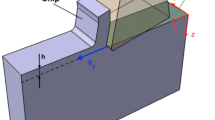Abstract
To study the surface residual stresses generated by machining Ti6Al4V alloy, we conducted some finite element simulations of the orthogonal cutting process using different cutting parameters. The simulation was based on the Arbitrary Lagrangian–Eulerian finite element approach. It shows that the tool geometry and the cutting parameters can affect the machining-induced surface residual stresses significantly in orthogonal cutting. To study the influences of the tool corner radius and tool feed per revolution on the surface residual stresses induced by a three-dimensional cutting process (which are always neglected in orthogonal cutting models), a plane strain condition-based indentation model was used to evaluate the corresponding effects. Based on the combination of the orthogonal cutting model and the orthogonal indentation model, the surface residual stresses generated in the three-dimensional cutting process could be modeled with much higher efficiency than with three-dimensional modeling. We conducted some corresponding experiments to validate the predicted results obtained from the model proposed in this paper and found that the results obtained from the two different methods were in satisfactory quantitative agreement.



















Similar content being viewed by others
References
Sasahara H (2005) The effect on fatigue life of residual stress and surface hardness resulting from different cutting conditions of 0.45% C steel. Int J Mach Tool Manuf 45(2):131–136
Jacobus K, DeVor RE, Kapoor SG (2000) Machining-induced residual stress: experimentation and modeling. J Manuf Sci Eng 122(1):20–31
Withers PJ (2007) Residual stress and its role in failure. Rep Prog Phys 70(12):2211
Meng L, He N, Yang Y, Zhao W, Rong B (2014) Method for measuring residual stresses induced by boring in internal surface of tube and its validation with XRD method. Nanjing Univ Aeronaut Astronaut 31(5):508–514
März B, Jolley K, Smith R et al (2018) Near-surface structure and residual stress in as-machined synthetic graphite. Mater Des 159:103–116
Moore MG, Evans WP (1958) Mathematical correction for stress in removed layers in X-ray diffraction residual stress analysis. SAE Technical Paper
Greving DJ, Rybicki EF, Shadley JR (1994) Through-thickness residual stress evaluations for several industrial thermal spray coatings using a modified layer-removal method. J Therm Spray Technol 3(4):379–388
Meng L, Atli M, Yang Y, Ning H (2016) Accurate measurement of the surface residual stresses generated by milling in pre-equilibrium state. J Mater Res 31(14):2076–2087
Meng LH, He N, Li L et al (2014) Measurement of pre-self-balanced surface residual stresses induced by milling in titanium alloys and the FEM validation. In: Advanced materials research. Trans Tech Publications, vol 996. pp 615–621
Meng L, He N, Li L, Yang Y, Zhao W (2014) Measurement of the residual stress induced by milling in TC4 workpiece before self-balancing and its FEA. Rare Met Mater Eng 43(8):1991–1996
Liang SY, Su JC (2007) Residual stress modeling in orthogonal machining. CIRP Ann 56(1):65–68
Lazoglu I, Ulutan D, Alaca BE, Engin S, Kaftanoglu B (2008) An enhanced analytical model for residual stress prediction in machining. CIRP Ann 57(1):81–84
Liu CR, Guo YB (2000) Finite element analysis of the effect of sequential cuts and tool–chip friction on residual stresses in a machined layer. Int J Mech Sci 42(6):1069–1086
Shih AJ, Yang HTY (1993) Experimental and finite element predictions of residual stresses due to orthogonal metal cutting. Int J Numer Methods Eng 36(9):1487–1507
Özel T, Ulutan D (2012) Prediction of machining induced residual stresses in turning of titanium and nickel based alloys with experiments and finite element simulations. CIRP Ann 61(1):547–550
Özel T, Zeren E (2005) Finite element modeling of stresses induced by high speed machining with round edge cutting tools. In: Proceedings of IMECE, vol 5, pp 1–9
Abboud E, Shi B, Attia H, Thomson V, Mebrahtu Y (2013) Finite element-based modeling of machining-induced residual stresses in Ti–6Al–4V under finish turning conditions. Procedia CIRP 8:63–68
Johnson GR, Cook WH (1983) A constitutive model and data for metals subjected to large strains, high strain rates and high temperatures. In: Proceedings of the 7th international symposium on ballistics, vol 21. pp 541–547
Lee WS, Lin CF (1998) High-temperature deformation behaviour of Ti6Al4V alloy evaluated by high strain-rate compression tests. J Mater Process Technol 75(1):127–136
Wang B, Liu Z (2016) Evaluation on fracture locus of serrated chip generation with stress triaxiality in high speed machining of Ti6Al4V. Mater Des 98:68–78
Umbrello D (2008) Finite element simulation of conventional and high speed machining of Ti6Al4V alloy. J Mater Process Technol 196(1):79–87
Zhang X, Zhang X, Srivastava AK (2011) Predicting the high speed cutting process of titanium alloy by finite element method. In: ASME 2011 international manufacturing science and engineering conference, American Society of Mechanical Engineers, pp 215–224
Jomaa W, Mechri O, Lévesque J et al (2017) Finite element simulation and analysis of serrated chip formation during high-speed machining of AA7075–T651 alloy. J Manuf Process 26:446–458
Sasahara H, Obikawa T, Shirakashi T (2004) Prediction model of surface residual stress within a machined surface by combining two orthogonal plane models. Int J Mach Tool Manuf 44(7):815–822
Meng L, He N, Yang Y, Zhao W (2015) Application of FEM correction to measuring the surface residual stresses generated by turning Ti6Al4V tube parts. J Harbin Inst Technol 47(5):71–75
Acknowledgements
Part of this work was supported by the Natural Science Foundation of Jiangsu Province (BK20190676), the Natural Science Foundation of the Jiangsu Higher Education Institutions of China (19KJB460019), the National Natural Science Foundation of China (51635003), the Natural Science Foundation of Anhui Province (1808085ME117), the Special Fund of Jiangsu Province for Transformation of Scientific and Technological Achievements (BA2017099).
Author information
Authors and Affiliations
Corresponding author
Additional information
Technical Editor: Lincoln Cardoso Brandao.
Publisher's Note
Springer Nature remains neutral with regard to jurisdictional claims in published maps and institutional affiliations.
Rights and permissions
About this article
Cite this article
Meng, L., Atli, M., Khan, A.M. et al. Prediction of residual stresses generated by machining Ti6Al4V alloy based on the combination of the ALE approach and indentation model. J Braz. Soc. Mech. Sci. Eng. 41, 471 (2019). https://doi.org/10.1007/s40430-019-1914-5
Received:
Accepted:
Published:
DOI: https://doi.org/10.1007/s40430-019-1914-5




